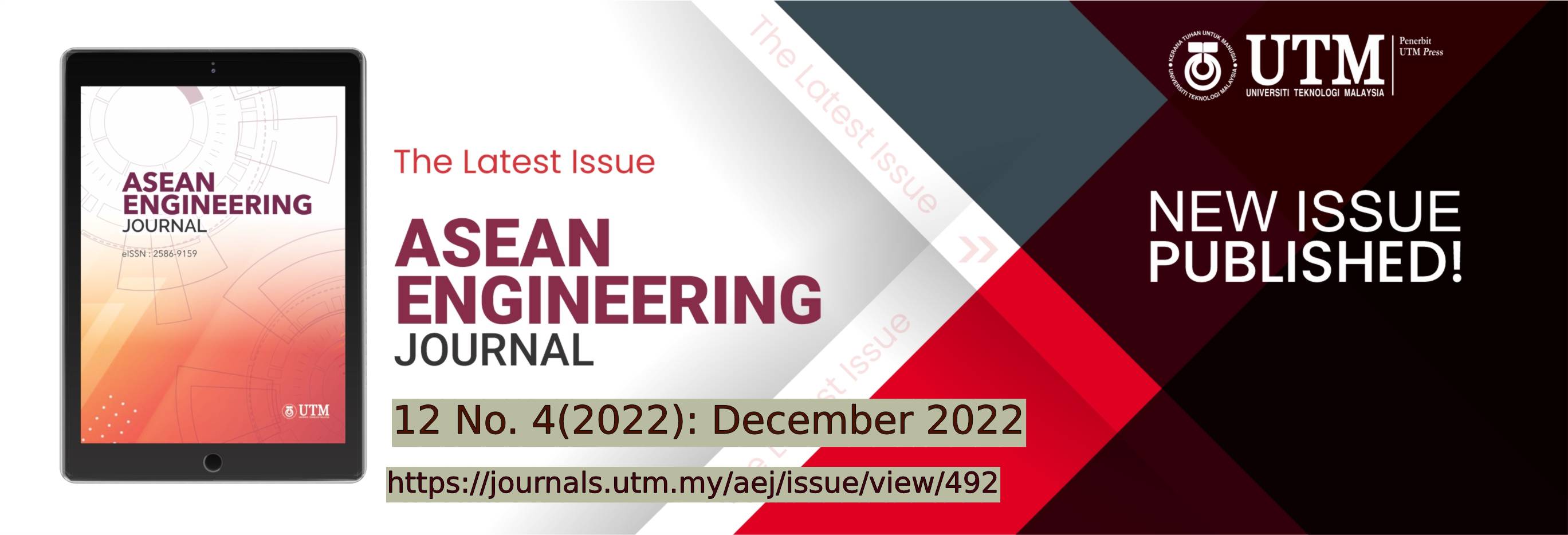REDUCTION OF PAPR USING ASYMMETRIC NUMERAL SYSTEM QC-LDPC WITH HUFFMAN AND ARITHMETIC CODING FOR F-OFDMA SYSTEM
DOI:
https://doi.org/10.11113/aej.v12.17957Keywords:
Arithmetic Coding (AC), Asymmetric Numeral Systems (ANS), Filtered-Orthogonal Frequency Division Multiple Access (F-OFDMA), Huffman Coding (HC), Quasi-Cyclic Low-Density Parity Check (QC-LDPC)Abstract
As modern wireless communication systems move towards 5G implementation, the system must provide sophisticated and ubiquitous service and flexibility. Therefore, Filtered Orthogonal Frequency Division Multiple Access (F-OFDMA) is one of the most suitable modulation techniques used in 5G systems to achieve efficient and reliable wireless communication. Other than that, F-OFDMA also has good quality rather than OFDM since it provides a better result of high side lobes and enlarges the scale of the spectrum analyzer. However, one of the significant problems in the F-OFDMA system is the high peak-to-average power ratio (PAPR), affecting the system's overall performance and causing high transmit power at the transmitter. In this paper, combination of Arithmetic Coding (AC) and Huffman coding (HC) with Asymmetric Numeral Systems (ANS) provide better performance for PAPR as well as bit error rate (BER) in F-OFDMA. Both AC and HC are proposed to combine with ANS and Quasi-Cyclic Low-Density Parity Check (QC-LDPC) since it provides a good result to defeat the high PAPR. BER and PAPR performance were compared for the AC and HC with ANS QC-LDPC. Based on the results, ANS-AC-QCLDPC proved as the best joint method has 35.25% improvement for PAPR while BER has 89.87%. This research also justified that ANS with Arithmetic-QCLDPC and Huffman-QCLDPC give better BER results as well.
References
Hasan, F.S. and Lateef, N.Q. 2021. Performance Comparison of
Multicarrier Communication Systems Over Doubly-selective Channels. Periodicals of Engineering and Natural Sciences. 9(3):12–21. DOI: https://doi.org/10.21533/pen.v9i3.2075
El-Tokhy, M.S., H.Ali, E. and Kasban, H. 2022. Development of Signal Recovery Algorithm for Overcoming PAPR in OFDMA Communication System. Arab Journal of Nuclear Sciences and Applications. 55(1):15–33. DOI: https://10.21608/ajnsa.2021.62290.1445
Kosolobov, D. 2022. The Efficiency of the ANS Entropy Encoding. ArXiv. 1-15. DOI: https://doi.org/10.48550/arXiv.2201.02514
Moffat, A. and Petri, M. 2017. ANS-Based Index Compression. In Proceedings of the ACM on Conference on Information and Knowledge Management. 677–686. DOI: https://doi.org/10.1145/3132847.3132888
Moffat, A. and Petri, M. 2018. Index Compression using Byte-Aligned ANS Coding and Two-Dimensional Contexts. In Proceeding of the 11th ACM International Conference on Web Search and Data Mining. 405–413. DOI: https://doi.org/10.1145/3159652.3159663
Dube, D. and Yokoo, H. 2019. Fast Construction of Almost Optimal Symbol Distributions for Asymmetric Numeral Systems. Proceedings of the IEEE International Symposium on Information Theory. 1682–1686. DOI: https://doi.org/10.1109/ISIT.2019.8849430
Selvakumar, M. and Sudhakar, B. 2021. Peak to Average Power Ratio Reduction for Filtered OFDM Modulation in 5G Frameworks Using Hybrid Techniques. Annals of the Romanian Society for Cell Biology. 25(1): 4302–4320. https://www.annalsofrscb.ro/index.php/journal/article/view/555
Yong, S.C, Jaekwon, K. and Won Young, Y. 2010. MIMO-OFDM Wireless Communications with MATLAB. 143–151. DOI: https://doi.org/10.1002/9780470825631
Sulong, S.M., Idris, A. and Sarnin, S.S. 2016. Performance Evaluation of CLS-DFE for MIMO OFDMA System. Journal of Advances in Computer Networks. 4(2):2–5. DOI: https://doi.org/10.18178/JACN.2016.4.2.212
Tamilselvi, T. and Rajendran, V. 2022. Comparative Analysis of CP-OFDM and F-OFDM Schemes for Cognitive Networks. In AIP Conference Proceedings 2385. DOI: https://doi.org/10.1063/5.0070769
El-Tokhy, M.S., H.Ali, E. and Kasban, H. 2022. Performance Improvement of OFDMA Systems Through Wireless Communication Channels. in Wireless Personal Communications. 124(3): 2447-2473. DOI: https://doi.org/10.1007/s11277-022-09472-w
[12] Kebede, T. , Wondie, Y., Steinbrunn, J. and Belay, H. 2022. Multi-carrier Waveforms and Multiple Access Strategies in Wireless Networks : Performance , Applications and Challenges. IEEE Access. 4:1–21. DOI: https://doi.org/10.1109/ACCESS.2022.3151360
Duda, J. 2013. Asymmetric Numeral Systems as Close to Capacity Low State Entropy Coders. ArXiv. 1-20. http://arxiv.org/abs/1311.2540
Duda, J. 2013. Asymmetric Numeral Systems: Entropy Coding Combining Speed of Huffman Coding with Compression Rate of Arithmetic Coding. ArXiv. 1311.2540(1): 1-24. DOI: https://doi.org/10.48550/arXiv.1311.2540
Tam, W., Lau, F. and Tse, C. 2010. A Class of QC-LDPC Codes with Low Encoding Complexity and Good Error Performance. IEEE Communications Letters, 14(2): 169-171. DOI: https://doi.org/10.1109/LCOMM.2010.02.091930
Sayood, K. 2018. Arithmetic Coding. Introduction to Data Compression. 5: 89–130. DOI:https://doi.org/10.1016/B978-0-12-809474-7.00004-5
Vimal, S.P., and Kumar, K.R.S. 2013. PAPR Reduction in OFDM systems using Quasi Cyclic LDPC Codes. Asian Journal of Scientific Research. 6(4): 715–725. DOI: https://doi.org/10.3923/ajsr.2013.715.725
Li, Z. Chen, L., Zeng, L. and Lin, S. 2006. Efficient Encoding of Quasi-Cyclic. IEEE Transaction on Communications. 54(1): 71–81. DOI: https://doi.org/10.1109/TCOMM.2005.861667
Moradi, S. and Gazor, S. 2006. An OFDM Rayleigh Fading Channel Simulator. Proceedings of the IEEE Vechicular TechnologyConference.1-5. DOI: https://doi.org/10.1109/VTCF.2006.427
Dang, S., Guo, S. and Justin, P. 2020. Enhanced Huffman Coded OFDM with Index Modulation. IEEE Transaction on Wireless Communications. 19(4): 2489–2503.DOI: https://doi.org/10.1109/TWC.2020.2965524
Vimal, S.P., Kumar, N.S. and Kasiselvanathan, M. 2020. Implementation of Adaptive Huffman Codes for PAPR Reduction in OFDM Systems. 37-44 .DOI: https://doi.org/10.1007/978-981-15-5029-4_3
Ashraf, E., Adel, M. and Elshirbini, A. 2008: Peak-to-Average Power Ratio Reduction in OFDM Systems using Huffman Coding. International Journal of Electronics and Communications Engineering 2008. 2(7): 266–270. DOI: https://doi.org/10.5281/zenodo.1329803
Cai, Y., Qin, Z. and Cui, F. 2018. Modulation and Multiple Access for 5G Networks. In IEEE Communications Surveys &Tutorials 629–646. DOI: https://doi.org/10.1109/COMST.2017.2766698
Juwono, F. and Gunawan, D. 2010. The Effectiveness of Using Source Coding to Reduce PAPR in OFDM System. Proceedings of International Conference on Wireless Communications Networking and Mobile Computing. 9:1–3. DOI: https://doi.org/10.1109/WICOM.2010.5601363
Wang, Z., Mei, L., Wang, X. and Zhang, N. 2017. Bit error Rate Analysis of Generalised Frequency Division Multiplexing with Weighted-type Fractional Fourier Transform Precoding. In IET Communications, 11(6): 916–924. DOI: https://doi.org/10.1049/iet-com.2016.0772
Noorazlina, M.S. , Sulong, S.M. and Idris, A. 2021. Design of MIMO F-OFDM System Model for PAPR Reduction in the Growth of 5G Network. Journal of Physics:Conference Series. 1793(1):1–7. DOI:https://doi.org/10.1088/1742-6596/1793/1/012067
















